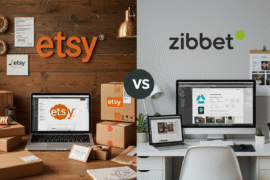This article may contain references to products or services from one or more of our advertisers or partners. We may receive compensation when you click on links to those products or services. Nonetheless, our opinions are our own.
The information presented in this article is accurate to the best of our knowledge at the time of publication. However, information is subject to change, and no guarantees are made about the continued accuracy or completeness of this content after its publication date.

Updated by Albert Fang
Anyone who has yet to dip a toe into the waters of online retail would do well to give it a shot. After all, even a global pandemic could do nothing to arrest the skyrocketing popularity of ecommerce: in fact, it only added to it. Online stores could keep operating very effectively while traditional retailers had to close down — all while consumers were stuck at home and eager to stock up on supplies (as well as some impulse purchases for comfort).
Factor in how accessible it is for modern sellers and you have perhaps the most flexible and utilitarian money-making path in the world at the moment. Most notably, it’s entirely possible to start with a modest side hustle (selling just a few items in your spare time) and seamlessly grow it into an enterprise-level operation.
But that growth is far from easy to achieve, particularly given how competitive the digital marketplace has become. Everyone wants a piece of the pie — and while there’s enough to go around, you have to battle for it. In this post, we’re going to set out four simple tactics that you can use to grow your ecommerce business. Let’s get started.
Run a Facebook Ads campaign
Social media is something that no ambitious business can afford to ignore. It captures so much attention (and in such exploitable ways) that you’re leaving money on the table if you don’t have a social strategy — and paid social advertising should be a key element of that strategy. But there are various viable options. What should you go with for the core PPC effort?
You do need such an effort, of course. PPC is a reliable driver of ROI: it’s the pragmatic constant in a sea of tactics that are much harder to get right. And as things currently stand, it isn’t necessary to use all viable platforms. You can just stick with one: Facebook Ads. Facebook is the biggest social network (having billions of active users), and it stores so much data.
Much of that data can be brought to bear when targeting your ads. If you want a given ad to go out to mechanical engineers living in a certain area, you can select the appropriate options. This level of targeting precision will allow you to get much more niche with your ad copy, leading you to lower costs in addition to better results.
Adopt hybrid marketing tactics
Hybrid marketing is all about using the online and offline worlds to promote your business, and stems from the recognition that you should be using all viable tactics — not just those that are on the cutting edge of technology. That isn’t to say that there isn’t unique technology involved in hybrid marketing, though, because there is.
Take pop-up shops, for instance. Running a pop-up shop using a pos system is a great way to promote an online retail store in a fresh environment, and it’s easier than you might think: there are pos systems for sale that can not only smoothly sync in-person sales with cloud inventories but even provide smart cash registers with data connections that can automate old-school transactions.
You can also draw upon methods for bringing digital analytics to offline marketing methods such as distributing mailers and making phone calls. Custom URLs and QR codes, custom phone numbers, and unique coupon codes: use them well and they’ll ensure that your offline marketing efforts slot neatly alongside your PPC campaigns.
Set up a subscription model
If you want to drive more recurring revenue and get better at retaining your ecommerce customers, adding a subscription model to your ecommerce store in addition to allowing one-off purchases could be a great way to fuel growth. The benefits of introducing a subscription model are plentiful:
- A more reliable, predictable revenue stream
- The ability to forecast more accurately
- More efficient inventory management
- The opportunity to build long-term customer loyalty
- Increased customer lifetime value (LTV)
- Lower customer acquisition costs
- Reduced customer churn
- A more streamlined customer experience
Using a subscription management service such as Chargebee, you can enable recurring payments on a range of products, with flexible pricing models, an optimized checkout process, automated churn management, and multiple upsell opportunities including add-on recommendations and product bundles.
Start selling through affiliate links
Affiliate marketing works very simply. You create some custom links to distribute to a varied set of sites and individuals influential in your niche, with each custom link leading to one of your products (or just your homepage). Those affiliates then drop those links into their content and seek to drive traffic towards them.
When someone uses an affiliate link to reach your site and subsequently buys something, you can use that unique link to determine which affiliate drove that traffic and reward them accordingly (perhaps with a set payment for a sale, or even with a commission). There are many ways to approach this: you can reach out to influencers directly, or take advantage of an existing affiliate network: here’s some more information on this option.
Create a compelling industry blog
Lastly, but far from least significantly, you can grow your ecommerce store through growing your brand with a content marketing strategy. More specifically, through creating a compelling industry blog: something that can stand out from anything your competitors have to offer. You have more tools than ever to achieve this. Much like you can use the Salesforce Automotive Cloud to target the auto industry, you can start writing content geared towards your specific niche as well. The more traffic you can attract to your blog, the more people will ultimately filter over to your store.
You can also promote your products within your content, naturally. It depends on the content you create, admittedly, but you could write about how and why you chose particular products for your brand (and link to those products in the process).
In the end, you could also seek to have your content featured on other sites in relevant industries: at a minimum, guest posting is a fantastic way to build up your profile and establish some working relationships that can prove highly beneficial down the line when you need advice or some business contacts.
Each of these four tactics can help you grow your ecommerce business at a faster rate, so think carefully about how you can work them into your general business plan.

Reviewed and edited by Albert Fang.
See a typo or want to suggest an edit/revision to the content? Use the contact us form to provide feedback.
At FangWallet, we value editorial integrity and open collaboration in curating quality content for readers to enjoy. Much appreciated for the assist.
Did you like our article and find it insightful? We encourage sharing the article link with family and friends to benefit as well - better yet, sharing on social media. Thank you for the support! 🍉
Article Title: 5 Simple Ways To Grow Your Ecommerce Store
https://fangwallet.com/2022/11/03/5-simple-ways-to-grow-your-ecommerce-store/The FangWallet Promise
FangWallet is an editorially independent resource - founded on breaking down challenging financial concepts for anyone to understand since 2014. While we adhere to editorial integrity, note that this post may contain references to products from our partners.
The FangWallet promise is always to have your best interest in mind and be transparent and honest about the financial picture.
Become an Insider

Subscribe to get a free daily budget planner printable to help get your money on track!
Make passive money the right way. No spam.
Editorial Disclaimer: The editorial content on this page is not provided by any of the companies mentioned. The opinions expressed here are the author's alone.
The content of this website is for informational purposes only and does not represent investment advice, or an offer or solicitation to buy or sell any security, investment, or product. Investors are encouraged to do their own due diligence, and, if necessary, consult professional advising before making any investment decisions. Investing involves a high degree of risk, and financial losses may occur including the potential loss of principal.
Source Citation References:
+ Inspo












































